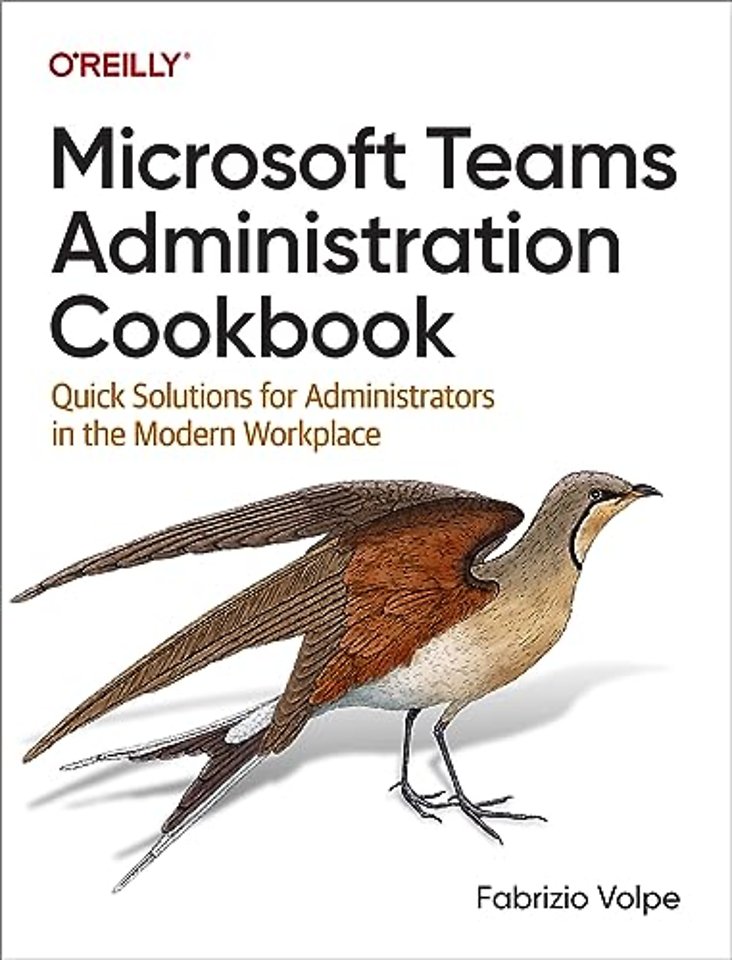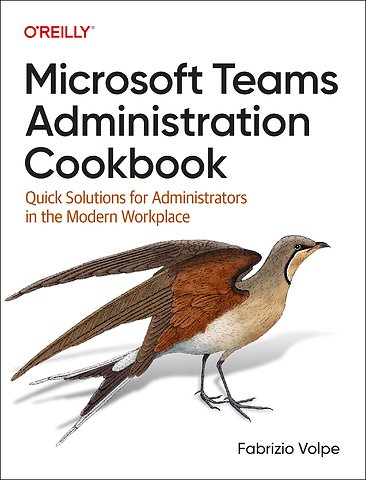Microsoft Teams Administration Cookbook
Paperback Engels 2023 1e druk 9781098133047Samenvatting
Microsoft Teams is used in hundreds of thousands of organizations to help keep remote and hybrid workplaces with dispersed workforces running smoothly. But while Microsoft Teams can seem easy for the user, Teams administrators must stay on top of a wide range of topics, including device administration techniques, quality benchmarks, and security and compliance measures.
With this handy cookbook, author Fabrizio Volpe provides a clear, concise overview of administrative tasks in Teams-along with step-by-step recipes to help you solve many of the common problems that system administrators, project managers, solution architects, and IT consultants may face when configuring, implementing, and managing Microsoft Teams. Think of this book as a detailed, immensely practical cheat sheet for Microsoft Teams administrators.
Recipes in the book will show you how to:
- Apply Teams best practices, compliance, and security
- Automate administrative tasks
- Successfully deploy Teams
- Implement Teams collaboration
- Deploy and manage Microsoft Teams Rooms
- Leverage the monitoring, productivity, and accessibility features
- Foresee roadblocks in migrations to Teams and Teams Voice
- Optimize Teams on virtual machines
Specificaties
Lezersrecensies
Inhoudsopgave
Who Should Use This Book
How to Use This Book
Conventions Used in This Book
O’Reilly Online Learning
How to Contact Us
Acknowledgments
1. Users and Teams Management
1.1. Reporting the Assigned Office 365 License
1.2. Allocating and Removing User Licenses
1.3. Scripting the Creation of Teams
1.4. Teams: Creating a Team with Dynamic Membership
1.5. Managing Apps in Teams and Channels
1.6. Creating User Reports: Active Users and Channels
1.7. Reporting Teams User Policies
1.8. Bulk Assignment of Teams User Policies
1.9. Summary
2. Microsoft Teams Security
2.1. Getting Teams Security Insights and Logs with Sentinel
2.2. Limiting Administrator Rights Allocation with Azure AD Privileged Identity Management
2.3. Blocking Malicious Links in Teams: Safe Links
2.4. Blocking and Allowing Teams Apps with App Control
2.5. Regulating Access to Teams with Conditional Access
2.6. Limiting the Domains Accepted for User Logins to Teams
2.7. Summary
3. Microsoft Teams Voice: Voice Users Deployment
3.1. Selecting a PSTN Connectivity Option for Teams
3.2. Migrating Voice from a Legacy PBX to Teams
3.3. Deploying Voice Recording for Teams Users
3.4. Creating Dial Plans
3.5. Managing Voice Routing Policies, Voice Routes, and PSTN Usages
3.6. Enabling Enterprise Voice for Teams Users
3.7. Summary
4. Analog Devices, DECT, and Legacy Hardware Integration with Teams Voice
4.1. Connecting Analog Devices to Teams SIP Gateway
4.2. Integrating Devices Not Supported by the SIP Gateway
4.3. Joining DECT Devices to Teams Phone System
4.4. Replacing Legacy Hardware
4.5. Summary
5. Advanced Voice Features in Microsoft Teams
5.1. Configuring and Managing Resource Accounts
5.2. Managing Common Phone Numbers with Call Queues
5.3. Updating Holidays for Auto Attendants in Teams
5.4. Delegating and Managing Call Groups
5.5. Enabling Call Park
5.6. Summary
6. Microsoft Teams Integration
6.1. Integrating Contact Centers with Microsoft Teams
6.2. Moving Existing File Servers to Teams
6.3. Leveraging Teams and Exchange Online Integration
6.4. Associating and Customizing SharePoint with Teams
6.5. Summary
7. Extending Microsoft Teams
7.1. Building a Chatbot
7.2. Using Adaptive Cards to Improve the Teams User Interface
7.3. Using and Configuring Webhooks in Teams
7.4. Deploying an App in Teams
7.5. Summary
8. Automating Teams Administration
8.1. Automating New Teams Approvals and Creation
8.2. Automating Teams Administration with PowerShell
8.3. Automating Teams Phone Number Management
8.4. Automating Administrative Tasks with Azure Automation
8.5. Summary
9. Microsoft Teams Rooms
9.1. Mixing In-Room and Remote Attendees
9.2. Preparing to Install the Equipment
9.3. Dealing with Internet Access and Security
9.4. MTR Commissioning
9.5. Managing Your Microsoft Teams Room
9.6. Summary
10. Monitoring Availability and Quality in Microsoft Teams
10.1. Checking Microsoft 365 Service Health
10.2. Monitoring Network Quality with Microsoft 365 Network Assessment Tools
10.3. Monitoring User Experience with Teams Analytics and Reports
10.4. Analyzing Call and Meeting Quality with the Call Quality Dashboard
10.5. Using Call Analytics to Identify Call Quality Issues
10.6. Summary
11. Collaborating with External Users
11.1. Activating External Identities
11.2. Collaborating with External Access and Guest Access
11.3. Accepting External Users in Your Organization: Shared Channels
11.4. Controlling Communication with Information Barriers
11.5. Summary
12. Productivity in Microsoft Teams
12.1. Improving Microsoft Teams with Microsoft Syntex
12.2. Integrating Loop with Microsoft Teams
12.3. Creating Power Automate Flows with AI Builder
12.4. Adding Personal Apps to Microsoft Teams
12.5. Summary
13. Teams and Virtual Machines
13.1. Managing Teams on Virtual Desktops
13.2. Using Windows 365 Cloud PCs with Microsoft Teams
13.3. Applying the Citrix HDX Optimization for Microsoft Teams
13.4. Deploying Media Optimization for Microsoft Teams in VMware Horizon
13.5. Summary
14. Accessibility and Inclusivity Features in Teams
14.1. Checking Accessibility in Microsoft 365 Apps
14.2. Improving Accessibility of Teams Meetings
14.3. Using Accessibility Features in the Teams Client
14.4. Using Microsoft Teams with the JAWS Virtual Cursor
14.5. Summary
15. Microsoft Teams Governance
15.1. Planning Governance in Teams
15.2. Enforcing a Naming Convention
15.3. Controlling Which Users Can Create Microsoft 365 Groups
15.4. Controlling Microsoft Teams Guest Access
15.5. Summary
16. Microsoft Teams Compliance
16.1. Applying Data Loss Prevention in Microsoft Teams
16.2. Enforcing Communication Compliance in Microsoft Teams
16.3. Managing the Information Lifecycle in Teams with Retention Policies
16.4. Assessing Compliance with Compliance Manager
16.5. Summary
17. Free and Open Source Tools for Microsoft Teams
17.1. Rendering Call Flows for Auto Attendants and Call Queues Automatically
17.2. Creating a Global Address Book for Teams
17.3. Merging Teams and SharePoint Activity Reports
17.4. Fixing Device Registration Issues
17.5. Gathering Additional Information from Microsoft 365
17.6. Summary
18. Teams and SharePoint
18.1. Matching Teams with the SharePoint Infrastructure
18.2. Enabling Conditional Access Policies for SharePoint Sites, OneDrive, and Teams
18.3. Using SharePoint Framework to Improve Teams
18.4. Summary
Teams and Viva Adoption Examples
A.1 Using Viva Insights for Employee Well-Being and Productivity
A.2 Managing Viva Learning to Make Personal Development a Natural Part of Your Day
A.3 Aligning Objectives and Key Results with Viva Goals
A.4 Adopting Viva Sales to Manage Sales Opportunities
A.5 Deploying Viva Connections and Viva Engage as Frontline Workers’ Hybrid Workplace
A.6 Harvesting and Curating Knowledge with Viva Topics
A.7 Persona Profiling and Modern Workplace Storyboards
A.8 Identifying Teams Power Users and Creating a Champion Network
A.9 Looking at Bite-Sized Adoption Tips for Teams Features
Summary
Index
About the Author
Anderen die dit boek kochten, kochten ook
Rubrieken
- advisering
- algemeen management
- coaching en trainen
- communicatie en media
- economie
- financieel management
- inkoop en logistiek
- internet en social media
- it-management / ict
- juridisch
- leiderschap
- marketing
- mens en maatschappij
- non-profit
- ondernemen
- organisatiekunde
- personal finance
- personeelsmanagement
- persoonlijke effectiviteit
- projectmanagement
- psychologie
- reclame en verkoop
- strategisch management
- verandermanagement
- werk en loopbaan







